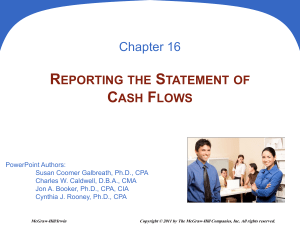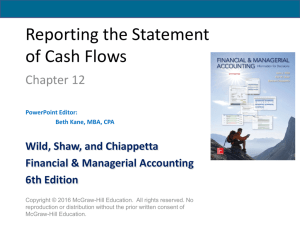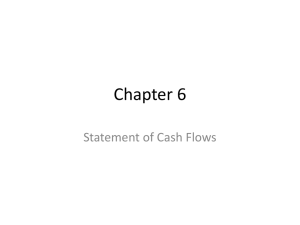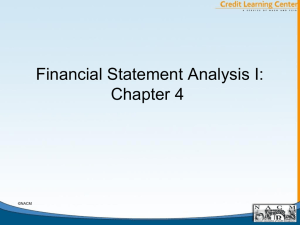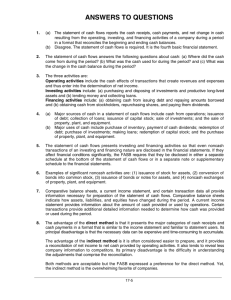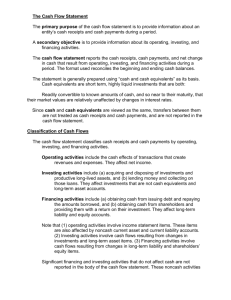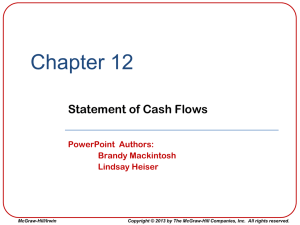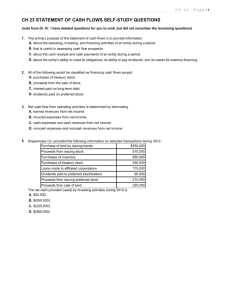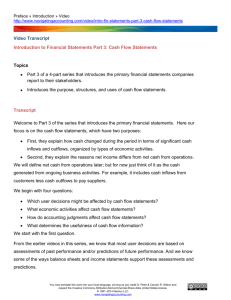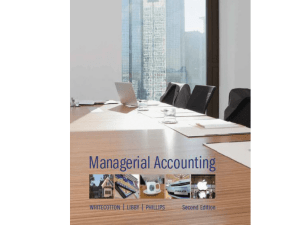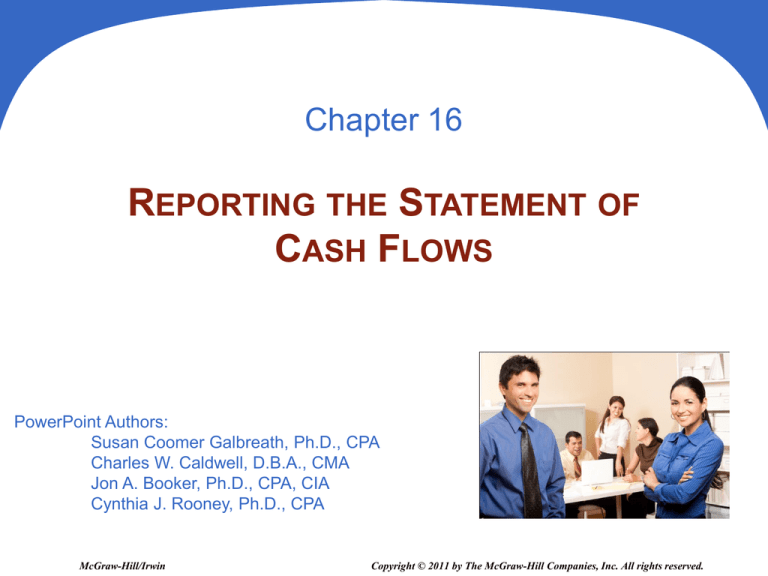
Chapter 16
REPORTING THE STATEMENT OF
CASH FLOWS
PowerPoint Authors:
Susan Coomer Galbreath, Ph.D., CPA
Charles W. Caldwell, D.B.A., CMA
Jon A. Booker, Ph.D., CPA, CIA
Cynthia J. Rooney, Ph.D., CPA
McGraw-Hill/Irwin
Copyright © 2011 by The McGraw-Hill Companies, Inc. All rights reserved.
16 - 2
PURPOSE OF THE STATEMENT
OF CASH FLOWS
How does a
company obtain its
cash?
Where does a
company spend its
cash?
What explains the
change in the cash
balance?
16 - 3
IMPORTANCE OF CASH FLOWS
How did the
business fund its
operations?
Does the business
have sufficient cash
to pay its debts as
they mature?
Did the business
make any dividend
payments?
Did the business
borrow any funds or
repay any loans?
16 - 4
MEASUREMENT OF CASH FLOWS
Cash
Equivalents
Cash
Currency
Short-term, highly liquid investments.
Readily convertible into cash.
Sufficiently close to maturity so that market value is
unaffected by interest rate changes.
16 - 5
C1
CLASSIFICATION OF CASH FLOWS
The Statement of Cash Flows
includes the following three
sections:
Operating Activities
Investing Activities
Financing Activities
16 - 6
C1
OPERATING ACTIVITIES
Inflows
Receipts from customers
Cash dividends received
Interest from borrowers
Other
Outflows
Salaries and wages
Payments to suppliers
Taxes and fines
Interest paid to lenders
Other
16 - 7
C1
INVESTING ACTIVITIES
Inflows
Selling long-term productive
assets
Selling equity investments
Collecting principal on loans
Other
Outflows
Purchasing long-term
productive assets
Purchasing equity
investments
Purchasing debt investments
Other
16 - 8
C1
FINANCING ACTIVITIES
Inflows
Issuing its own equity
securities
Issuing bonds and notes
Issuing short- and long-term
liabilities
Contributions by owners
Outflows
Pay dividends
Purchasing treasury stock
Repaying cash loans
Paying owners’ withdrawals
16 - 9
C1
NONCASH INVESTING AND FINANCING
Items requiring separate disclosure
include:
Retirement of debt by issuing equity
securities.
Conversion of preferred stock to
common stock.
Leasing of assets in a capital lease
transaction.
16 - 10
FORMAT OF THE STATEMENT
OF CASH FLOWS
16 - 11
P1
PREPARING THE STATEMENT
OF CASH FLOWS
16 - 12
P1
ANALYZING THE CASH ACCOUNT
The Cash account is a natural place to look for
information about cash flows from operating,
investing, and financing activities.
16 - 13
P1
ANALYZING THE CASH ACCOUNT
Cash from
Operating
Cash from
Investing
Cash from
Financing
Cash
Provided
16 - 14
P1
ANALYZING NONCASH ACCOUNT
A second approach to preparing the statement
of cash flows is analyzing noncash accounts.
16 - 15
P1
INFORMATION TO PREPARE THE STATEMENT
Information to prepare the statement of cash
flows usually comes from three sources:
Comparative
Balance Sheets
Current
Income Statement
Additional
Information
16 - 16
CASH FLOWS FROM OPERATING
INDIRECT AND DIRECT METHODS OF REPORTING
Direct
Method
Indirect
Method
The net cash amount provided by operating activities is
identical under both the direct and indirect methods.
P2
APPLICATION OF THE
INDIRECT METHOD OF REPORTING
16 - 17
16 - 18
P2
APPLICATION OF THE
INDIRECT METHOD OF REPORTING
Additional information on Genesis Inc.’s 2011 transactions:
a) The accounts payable balances result from merchandise
inventory purchases.
b) Purchased $70,000 in plant assets by paying $10,000 cash
and issuing $60,000 of notes payable.
c) Sold plant assets with an original cost of $30,000 and
accumulated depreciation of $12,000 for $12,000 cash,
yielding a $6,000 loss.
d) Received $15,000 cash from issuing 3,000 shares of
common stock.
e) Paid $18,000 cash to retire notes with a $34,000 book value,
yielding a $16,000 gain.
f) Declared and paid cash dividends of $14,000.
16 - 19
P2
APPLICATION OF THE
INDIRECT METHOD OF REPORTING
Changes in noncash
current assets and current
liabilities
1
Net
Income
2
+ Noncash
expenses such as
depreciation and
amortization
Cash Flows
from Operating
Activities
3
+ Losses and
- Gains
16 - 20
P2
ADJUSTMENTS FOR CHANGES IN
CURRENT ASSETS AND CURRENT LIABILITIES
Current
Assets
Current
Liabilities
Change in Account Balance During Year
Increase
Decrease
Subtract from net
Add to net income.
income.
Add to net income.
Subtract from net
income.
Use this table when adjusting Net Income
to Operating Cash Flows.
16 - 21
P2
ADJUSTMENTS FOR CHANGES IN
CURRENT ASSETS AND CURRENT LIABILITIES
16 - 22
P2
ADJUSTMENTS FOR OPERATING ITEMS
NOT PROVIDING OR USING CASH
16 - 23
P2
ADJUSTMENTS FOR NONOPERATING ITEMS
16 - 24
P2
SUMMARY OF ADJUSTMENTS
FOR INDIRECT METHOD
Common adjustments to net income when computing net
cash provided or used by operating activities under the
indirect method:
16 - 25
P3
CASH FLOWS FROM INVESTING
A three-stage process to determine cash
provided or used by investing activities:
Identify changes in
investing-related
accounts
Explain these
changes using
reconstruction
analysis
Report their cash
flow effects
16 - 26
P3
CASH FLOWS FROM INVESTING
This analysis reveals a $40,000
increase in plant assets from
$210,000 to $250,000 and a
$12,000 increase in
accumulated depreciation from
$48,000 to $60,000.
16 - 27
P3
CASH FLOWS FROM INVESTING
Item b: Genesis purchased plant assets of $70,000 by issuing
$60,000 in notes payable to the seller and paying $10,000 in cash.
Item c: Genesis sold plant assets costing $30,000 (with $12,000 of
accumulated depreciation) for $12,000 cash, resulting in a $6,000
loss.
We also reconstruct the entry for Depreciation Expense using
information from the income statement.
16 - 28
P3
CASH FLOWS FROM INVESTING
16 - 29
P3
CASH FLOWS FROM FINANCING
A three-stage process to determine cash
provided or used by financing activities:
Identify changes in
financing-related
accounts
Explain these
changes using
reconstruction
analysis
Report their cash
flow effects
16 - 30
P3
CASH FLOWS FROM FINANCING
This analysis reveals:
1. an increase in notes payable
from $64,000 to $90,000,
2. an increase in common
stock from $80,000 to
$95,000, and
3. an increase in retained
earnings from $88,000 to
$112,000.
16 - 31
P3
CASH FLOWS FROM FINANCING
Item e: Notes with a carrying value of $34,000 are retired for $18,000
cash, resulting in a $16,000 gain.
Item b: Genesis purchased plant assets of $70,000 by issuing
$60,000 in notes payable to the seller and paying $10,000 in cash.
16 - 32
P3
CASH FLOWS FROM FINANCING
Item d: Issued 3,000 shares of common stock at par for $5 per share.
Item f: Cash dividends of $14,000 are paid.
16 - 33
P3
16 - 34
P3
16 - 35
GLOBAL VIEW
Reporting Cash Flows from Operating
Both U.S. GAAP and IFRS permit the reporting of cash flows from operating
activities using either the direct or indirect method. However, two notable
differences include:
1. U.S. GAAP requires cash inflows from interest revenue and dividend revenue be
classified as operating, whereas IFRS permits classification under operating or
investing provided that this classification is consistently applied across
periods.
2. U.S. GAAP requires cash outflows for interest expense be classified as
operating, whereas IFRS again permits classification under operating or
financing provided that it is consistently applied across periods.
Reporting Cash Flows from Investing and Financing
U.S. GAAP and IFRS are broadly similar in computing and classifying cash flows
from investing and financing activities. One notable exception is that U.S. GAAP
requires cash outflows for income tax be classified as operating, whereas IFRS
permits the splitting of those cash flows among operating, investing, and
financing depending on the sources of that tax.
16 - 36
A1
ANALYZING CASH
SOURCES AND USES
Most managers stress the importance of
understanding and predicting cash flows for business
decisions.
16 - 37
A1
CASH FLOW ON TOTAL ASSETS
Used, along with income-based ratios, to
assess company performance.
Cash flow on
total assets
=
Operating cash flows
Average total assets
16 - 38
P4
Appendix 16A:
Spreadsheet
Preparation of
the Statement of
Cash Flows
A spreadsheet,
also called work
sheet or working
paper, can help us
organize the
information
needed to prepare
a statement of
cash flows.
16 - 39
P5
APPENDIX 16B: DIRECT METHOD OF
REPORTING OPERATING CASH FLOWS
Adjust income statement accounts related to operating activities
for changes in their related balance sheet accounts:
Framework for
reporting cash
receipts and
cash payments
16 - 40
P5
APPENDIX 16B: DIRECT METHOD OF
REPORTING OPERATING CASH FLOWS
16 - 41
END OF CHAPTER 16

